![]() 1st Battalion 22nd Infantry
1st Battalion 22nd Infantry ![]()
Memorial cannon for 22nd Commander found in the Philippines
Page Two - Recovery and restoration
Though the land around the
monument to Harry C. Egbert was designated in 1906, as
being reserved for the monument, over time that designation
obviously came to be ignored.
The area surrounding the monument was swallowed up in the
expansion of the city of
Valenzuela, the township of Malinta being annexed by the city,
and the Egbert site was
taken over by city projects. What was left of the monument area
eventually ended up
being occupied by a playground basketball court, with the
monument's cannon sticking
up out the ground.
Attempts to remove the cannon
over the years were resisted by the local inhabitants,
who remained true to their ancestors' promises, that they, and
their descendants would
look after the monument, and hold it as being special to the
place where it was established.
The following article gives details on the cannon's recovery.

BEFORE it was taken off the ground, the heavy gun dating back to the mid-1800s appeared as a stump in the middle of a dirt basketball court.
VALENZUELA PUBLIC INFORMATION
OFFICE
History goes boom in Valenzuela; slums yield massive war artifact
Saturday, October 27th, 2012
For years it lay partly buried,
of all places, in the middle of a dirt basketball court. But
local residents who had long considered it
part of their community finally agreed to have it excavated,
restored, and shared with the rest of the Filipino people.
A 9-ton cannon dating back to the 1800s was recently unearthed in
a slum area near Valenzuela City Hall in Barangay Malinta.
The artillery piece, about 10
feet long, was made in Spain but later dedicated by the Americans
to a US colonel who served in the
Philippine-American War, according Jonathan Balsamo, curator of
Museo Valenzuela and head of the restoration project.
Balsamo said the war relic would undergo restoration in the next
few months as a heritage piece of the city. And though the cannon
bore
inscriptions in memory of an American officer, he said it should
now serve as a reminder of the Filipinos who fought in the Battle
of Malinta,
a rarely told episode in the war that raged from 1899 to 1902.
“The cannon’s body
indicates that it was made in 1859 in Trubia, a village in
Asturias, Spain, known for making cannons,”
Balsamo told the Inquirer in an interview last week.
After the war, additional
inscriptions were made and remained legible to this day: “In
memory of Col. Harry Clay Egbert, US Army,
Brigadier General–US Volunteers, who was mortally wounded on
this spot while leading his regiment, the 22nd US Infantry,
26th March 1899.”
“Historical accounts
indicate that Egbert died in the Battle of Malinta. And what is
fascinating about this part of the
Philippine-American War is that while the Americans were able to
control Malinta, they did not defeat the Filipinos in actual
battle,”
Balsamo said. The Filipino fighters took cover in a church when
they saw the Americans approaching, he said, quoting records.
Aware of the range of their rifles, they waited for the right
distance before firing at enemy troops as they went past the
church.
“That was when Egbert was
killed,” he said. “The Filipinos pulled back only when
they ran out of bullets.”
The American colonial government under Acting Governor General
Henry Ide later marked Egbert’s fall by building a memorial
in the area. A 1906 proclamation designated a tract of land in
Malinta (then still under the jurisdiction of Bulacan province)
as the Egbert Monument Reserve.
“The place was landscaped
and this cannon, complete with the inscriptions, was erected at
the center of the monument,”
Balsamo said.
However, the monument fell into
neglect in the years that followed. In the 1990s, the cannon
ended up being “swallowed”
by the earth after treasure hunters dug a tunnel beneath it,
Balsamo said.
After the diggings, only the
cannon’s tip—showing the parts known as the knob and
the neck—remained visible aboveground,
and it oddly jutted out at an angle in the middle of what is now
an unpaved basketball court. Also, parts of fence marking the
monument still stand.
“Over the years, under
previous city administrations, there have been many attempts to
recover the cannon. They all failed
for various reasons, but mainly because residents in the area
resisted the plan,” Balsamo said.
“They were reluctant to
have the cannon excavated, saying their ancestors were allowed by
the Americans to look after
that piece of land,” he said. Some residents even threatened
to bring the issue to court.
“We had to hold a dialogue
in late September to inform them that we will restore the cannon.
It was only then that we were able
to persuade them and start digging,” the museum official
said.
It took around 60 workers two
days to get the rusty cannon out and another day just to drag it
to the road where a forklift
was waiting. The massive gun is currently kept in a warehouse,
its restoration to be funded by the city government and
handled by experts from the National Historical Commission of the
Philippines.
“After the restoration, we
plan to put it on display at City Hall grounds for everyone to
see,” Balsamo said. “But through it
we are now recognizing the unnamed Filipino soldiers who fought
Egbert and his troops in the Battle of Malinta.”
“For me, this cannon is now
about the Filipinos who showed courage and nationalism, soldiers
who were never paid to fight
yet stood up in defense of our country,” he said. “This
is not just about the appreciation of an artifact. It goes
deeper.
It should make us think: What form of heroism can we do for our
country now?”
By Nathaniel
R. Melican
Philippine
Daily Inquirer
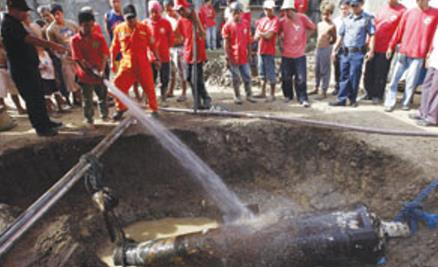
A Filipino worker directs a water hose
onto what is believed to be a Spanish-period cannon retrieved in
Malinta town in Valenzuela City,
northwest of Manila, Philippines, yesterday. According to Museo
Valenzuela (Valenzuela Museum) curator Jonathan Balsamo,
engravings on the cannon indicate that it was used as a memorial
marker for one US army colonel Harry Clay Egbert, who was
mortally wounded
on March 26, 1899, while leading the 22nd US Infantry against
Filipino fighters during the time of the Filipino-American war in
the Philippines.
The cannon, measuring approximately 10-feet, also had the marking
of ‘Trubia 1859.’ Balsamo said the marking suggests
that the cannon
could have been cast in Trubia, a place in Asturias, Spain in
1859
Photo from the Gulf
Times
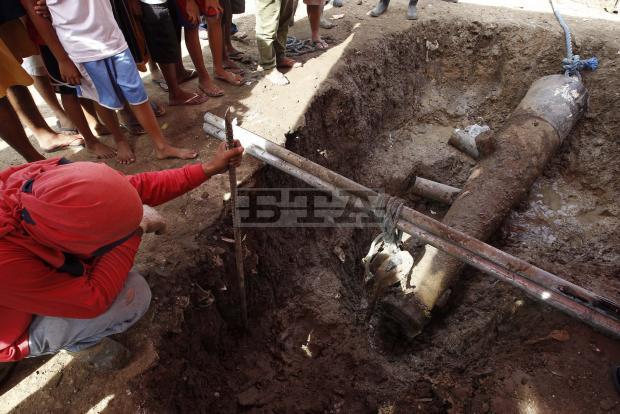
Here the cannon is being prepared to be lifted from the excavation
Photo from BTA Bulgarian News Agency
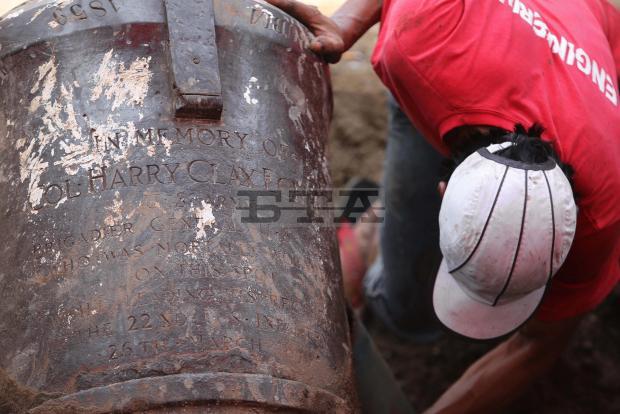
The engraving on the cannon can be seen as a worker aids in lifting the cannon
Photo from BTA Bulgarian News Agency
The engraving reads:
IN MEMORY OF
COL · HARRY CLAY EGBERT
U · S ARMY
BRIGADIER GENERAL U · S VOLUNTEERS
WHO WAS MORTALLY WOUNDED
ON THIS SPOT
WHILE LEADING HIS REGIMENT
THE 22 ND U · S · INFANTRY
26TH · MARCH 1899
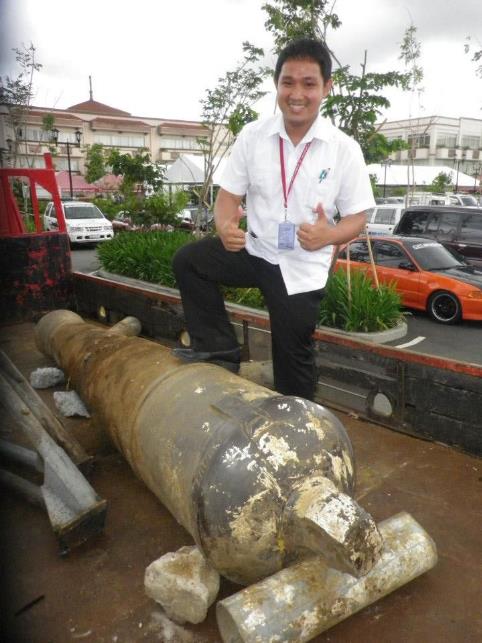
Mr. Jonathan Balsamo, curator of the
Museo Valenzuela,
with the cannon moved to the museum's facility in Valenzuela
City, Philippines.
Photo courtesy of Kevin Perez
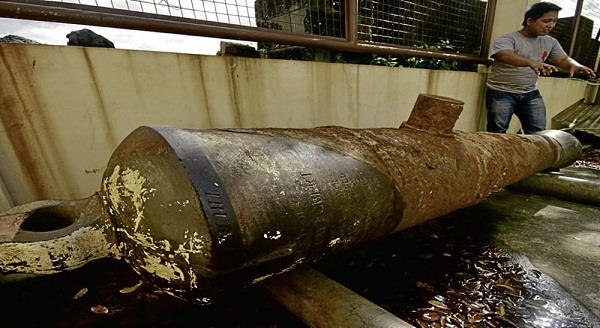
FINALLY unearthed, the massive
“Egbert cannon” will undergo restoration by experts
from the National Historical Commission of the Philippines.
October 27th, 2012
ALANAH TORRALBA from Inquirer.net
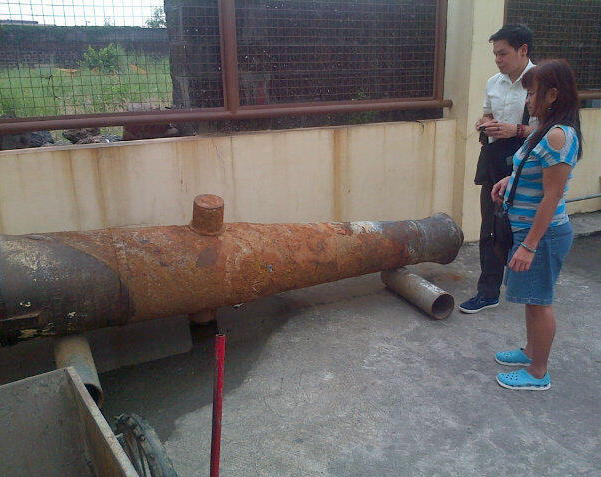
Nhcp conservators Romel Aquino n Dolly inspecting Egbert Cannon for restoration
Jonathan Balsamo Twicsy website
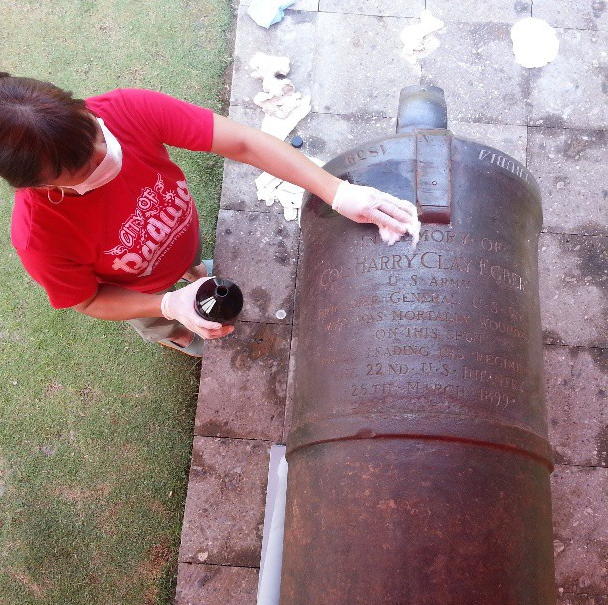
A conservationist from the National
Historical Commission of the Philippines
wipes the Col. Harry Clay Egbert memorial cannon with acetone.
Mark Lester Cayabyab's photostream
Home | Photos | Battles & History | Current |
Rosters & Reports | Medal of Honor | Killed
in Action |
Personnel Locator | Commanders | Station
List | Campaigns |
Honors | Insignia & Memorabilia | 4-42
Artillery | Taps |
What's New | Editorial | Links |